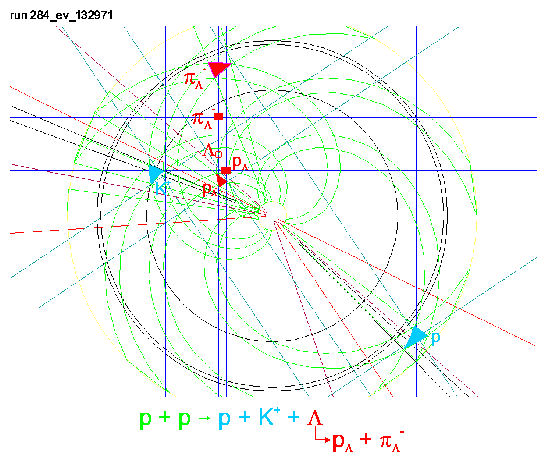| Investigation of the Associated Strangeness Production in the Reaction pp ® pK+L B,K | |||
|---|---|---|---|
|
K. Möller, S. Dshemuchadse |
|||
|
One of the main topics of the physics program of the COSY TOF collaboration is the investigation of the associated strangeness production in pp reactions at COSY energies up to 2.5 GeV. Quite a lot of data has been accumulated in recent beam times. So, there is an urgent need for analysing these data. To support and speed up the analysis a computer code was developed by the Rossendorf COSY TOF group for analysing the associated strangeness production of L hyperons. In this code a new concept was applied to search for primary and secondary tracks in the data. |
|||

|
|||
| Fig. 1 A pKL event at proton momentum 2.85 GeV/c. | |||
|
One example is shown in Fig. 1 which demonstrates that the developed computer code is capable of detecting pKL events. In the figure a hit display is shown with the following colour assignments for the different position sensitive detector elements: start detector sectors (red), microstrip sector and ring elements (black), fiber hodoscope 1 (blue), fiber hodoscope 2 (blue-green) and the endcap (quirl) elements (green). In the first step of the pp-reaction shown in Fig. 1 a proton, a kaon and a lambda particle are generated with the latter one decaying into a proton and a pion in a secondary process. After the software development was finished in a first check a data tape was reanalysed which was analysed somewhat earlier by the Erlangen COSY TOF group. In most cases good agreement was found in the set of event numbers attributed to pKL events. For events with event numbers which did not coincide the reason for the disagreement was analysed. This led to a further refinement of the computer codes. Thus by applying two different codes for data analysis the accuracy of the results obtained by the TOF collaboration can be significantly increased. After checking the reliability of the Rossendorf pKL analysis concept the developed computer code is now ready to be applied to data not yet analyzed up to now. Due to the modular structure of the analysis program (written in C++) the code can easily be modified to analyse also channels other than the associated L production, e.g., the S production in the channels pp ® pK+S0 and pp ® pK0S+. |
|||
|